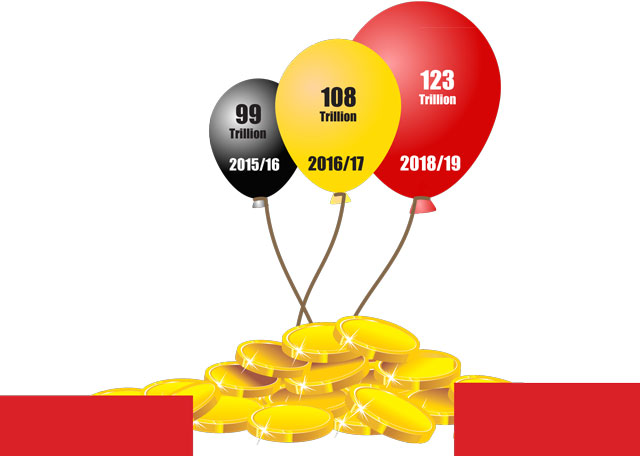
Bigger Economy: Why could that be bad news?
Kampala, Uganda | THE INDEPENDENT | The recent rebasing of the national account series by the Uganda Bureau of Statistics (UBOS) has excited economists with many saying it presents the government an opportunity to make policy based on data that is a true reflection of the economy.
“It is good to rebase because it helps a country to know the resources it has and this facilitates a country’s planning,” said Paul Lakuma; a Research Fellow at the Macroeconomic department at the Economic Policy research Centre, Makerere University, “If a country doesn’t know the resources that it has, it may even end up borrowing money abroad that would have been sourced locally.”
The new base year is FY 2016/17 which means it is the new reference period. The new base year will now be the starting point or basis for measuring the performance of the economy over a period, usually five years. Based on FY 2016/17, the Gross Domestic Product (GDP) which measures all output in the economy has been updated.
At the launch of the rebased GDP estimates on Oct.10 at Statistics House in Kampala, UBOS splashed an array of dazzling numbers, figures, and graphs that favoured understanding of only experts. The bottom line, however, is that the rebasing gives the latest picture of the structure of the economy based on the supply and demand of goods and services, technically called the Supply and Use Tables (SUTs). At the event, UBOS also launched the third publication of SUTs.
Under the rebasing, the Uganda economy became bigger by 18.3% based on the difference between the previously published and revised figures of FY 2016/17. Under the figures economists have been using, the size of economy or Gross Domestic Product (GDP) was Shs92 trillion. In the revised figures, the GDP is Shs109 trillion for FY2016/17. The GDP per capita also jumped from US$807 equivalent to US$833 for FY 2016/17.
The new series also gave revised GDP numbers for subsequent years. The previously published size of economy or GDP of Uganda in FY2018/19 was Shs110 trillion. In the revised series the Uganda GDP for FY2018/19 is Shs123 trillion. That means the economy is 11.8% bigger today than was earlier estimated.

Developing the SUTs and rebasing an economy are highly technical and complex exercises. It used data from the Uganda National Population and Housing Census 2014, the 2016/17 Uganda National Household Survey (UNHS), turnover data and income tax statements, administrative data from Ministries, government departments and agencies (MDAs) and Local Governments.
“The availability of more comprehensive source data and revisions in computational approach resulted into improvements in the Supply and Use Tables and GDP estimates,” the UBOS Executive Director, Chris Mukiza (PhD), said.
The last rebasing of Uganda’s economy was in 2014 to base year 2009/10. An earlier rebasing occurred in 2002.
Lukuma told The Independent that the latest rebasing of the Ugandan economy captures the component of oil and gas that is not in the physical infrastructure that exists at the moment.
“Without capturing that component of oil and gas infrastructure, you will not know the latter sector’s contribution to the economy, and you wouldn’t actually know the real size of the economy,” he said.
The previous rebasing to FY2009/10 captured the contributions of mobile money to the economy while the 2005 rebasing focused on capturing the contribution of the services sector to the economy, he said.
The latest rebasing shows that the size of Uganda economy or GDP at constant 2016/17 prices is now Shs123 trillion (Approx. US$34 billion) in real and not nominal values, which is a jump from the Shs115 trillion in FY2017/18.
In FY2016/17 the real GDP was Shs109 trillion (approx. US$30 billion) as announced in the June 2019/20 budget speech by the Minister of Finance, Matia Kasaija. The rebasing has led to 11% rise in the size of the Ugandan economy.
This has big implications for government planners and individuals. It means different national account numbers will be referenced to the new revised figures. Economic growth rates, ratios, or indicators of business activity performance will now be measured with 2016 as the point of comparison.
Important measurements could include the rate of GDP growth, inflation, prices, tax revenue, incomes, poverty levels, sector contributions to GDP and more. Making the comparisons depends on availability of relevant statistics.
Previously published estimates of real GDP at constant prices of the previous base year 2009/10 were Shs 58 trillion for 2016/17, and Shs62 trillion for 2017/18, and Shs65 trillion for 2018/19.
The rates of GDP growth in the new rebased series for the four years, 2015-2019 have also risen marginally. Under the new series (at 2016/17 constant prices) the Uganda economy has averagely grown 5.3% while under the old series of 2009/10 constant prices, the economy grew 5.2% averagely.
 The Independent Uganda: You get the Truth we Pay the Price
The Independent Uganda: You get the Truth we Pay the Price





